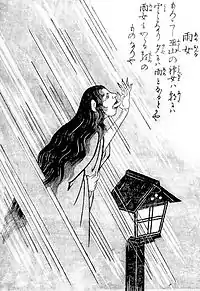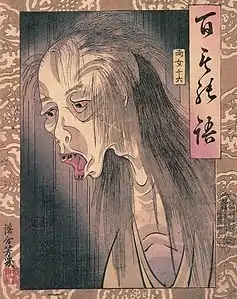Ameonna
Ameonna (雨女, "rain woman") is a Japanese yōkai thought to call forth rain, illustrated in Toriyama Sekien's Konjaku Hyakki Shūi as a woman standing in the rain and licking her hand.


In modern usage in Japan, "ameonna" (or the male equivalent "ameotoko") refers to an unlucky person that seems to be jinxed to have the rain follow them wherever they may go, thus gaining a reputation for ruining special events such as weddings or sporting events.
Origins
In the collection of yōkai pictures, the Konjaku Hyakki Shūi by Toriyama Sekien, there is a picture titled "ameonna," and the explanatory text says "in Fuzan (Wu Shan), China, the goddesses become a cloud in morning and rain in the evening. The ameonna is probably like one of these" (もろこし巫山の神女は 朝には雲となり 夕には雨となるとかや 雨女もかかる類のものなりや). This quotes from an episode in the Gaotangfu (高唐賦) by the Chu literati Song Yu, wherein King Huai of Chu had a dream about falling in love with a woman in Wu Shan who, before leaving, left the words "I will be clouds in the morning, and rain in the evening, so at morning and evening, let's meet down at the balcony," and 朝雲暮雨 (Chaoyunmuyu in Chinese, Chōunbō in Japanese), written as "morning cloud evening rain," is an old chengyu (Chinese proverb) referring to secret relations between a man and woman.[1] There are no statements about any rain-related yōkai to be seen,[2] so it's been suggested that the ameonna is simply a made-up creation by Sekien in order to satirize the Edo Period Yoshiwara Yūkaku.[3]
There is also the idea put forth that women who lose their recently born children on a day of rain due to a kamikakushi (spiriting away) would become rain women (ameonna), so they would appear before crying children carrying a large sack.[4]
Sometimes, they are considered a "bothersome yōkai that calls forth rain," but they are also sometimes considered a holy "rain god" as a "yōkai who saves people by calling forth rain" in times of continuing drought by making it rain.[5]
In Shimoina District, Nagano Prefecture, there is an eerie woman called "yukionba" (雨おんば) said to appear on rainy nights,[6] and it has been supposed that they are a yōkai that kidnaps children,[7] or a god that visits on rainy days who has fallen and turned into a yōkai, among other suggestions.[8]
References
- 稲田篤信・田中直日編, ed. (1992). 鳥山石燕 画図百鬼夜行. 高田衛監修. 国書刊行会. p. 215. ISBN 978-4-336-03386-4.
- 村上健司編著 (2005). 日本妖怪大事典. Kwai books. 角川書店. p. 22. ISBN 978-4-04-883926-6.
- 多田克己 (2006). 百鬼解読. 講談社文庫. 講談社. p. 20. ISBN 978-4-06-275484-2.
- 山口敏太郎 (2007). 本当にいる日本の「現代妖怪」図鑑. 笠倉出版社. p. 124. ISBN 978-4-7730-0365-9.
- 水木しげる (1996). 妖怪大図鑑. 講談社まんが百科. Vol. II. 講談社. p. 14. ISBN 978-4-06-259041-9.
- 日野巌・日野綏彦 (2006). "日本妖怪変化語彙". 動物妖怪譚. 中公文庫. Vol. 下. 村上健司校訂. 中央公論新社. p. 229. ISBN 978-4-12-204792-1.
- 千葉幹夫 (1991). 妖怪お化け雑学事典. 講談社. p. 113. ISBN 978-4-06-205172-9.
- 日本の妖怪百科. Vol. 3. 岩井宏實監修. 河出書房新社. 2000. p. 63. ISBN 978-4-309-61380-2.
{{cite book}}: CS1 maint: others (link)
- Mizuki, Shigeru (2003). Mujara 2: Chūbu-hen. Japan: Soft Garage. p. 13. ISBN 978-4861330056.
- CSK: Hyakki Yagyō: Ameonna
- Japanese Wikipedia: Ameonna